LESSON 9
PERFORM FIRST AID FOR A SUSPECTED FRACTURE
Splint a suspected fracture of the arm or leg.
CONDITIONS
Given a simulated casualty with a suspected fracture of the arm or leg and needed materials.
STANDARD
Score a GO on the performance checklist.
REFERENCES
STP 21-1-SMCT, Soldier's Manual of Common Tasks: Skill Level 1.
FM 21-11, First Aid for Soldiers.
9-1. INTRODUCTION
A fracture is a break in a bone. A fracture can cause discomfort, disability, and even death.
A closed fracture is a break in the bone without a break in the skin. Even though the skin is not cut or broken, the tissue beneath the skin may be damaged.
An open fracture is a break in the bone with a break in the overlying skin as well. The break in the skin may be caused by the sharp end of the broken bone or by a foreign object, such as a bullet, penetrating the skin. Open fractures are especially serious due to the danger of infection.
A dislocation occurs when the bones comprising a joint (elbow, knee, wrist, etc.) are forced out of their proper positions.
A sprain results when a joint is twisted beyond its normal limits of motion and the connecting tissues around the joint tear.
A dislocation or sprain can produce signs and symptoms similar to those of a fracture and should be treated as a fracture of the joint.
9-2. IDENTIFY SIGNS AND SYMPTOMS OF A FRACTURED ARM OR LEG
Some of the signs and symptoms of a fractured limb (arm or leg) are:
Bone sticking through the skin.
Pain, tenderness, swelling, and/or bruise at a particular location. (The site of the tenderness or bruise is probably the site of the fracture.)
Arm or leg appears to be shorter or is in an abnormal position (looks deformed).
Difficulty in moving an arm or leg.
CAUTION: Do not have the casualty attempt to move the injured arm or leg to test this symptom. Rely upon what the casualty tells you.
Massive injury to an arm or leg. (Even if the bone is not broken, the pain caused by the wound may be lessened if the arm or leg is splinted after it has been dressed and bandaged.)
"Snapping" sound heard by the casualty at the time of the injury.
9-3. PREPARE THE CASUALTY
There are some actions that need to be taken before you splint the suspected fracture.
a. Reassure Casualty
Tell the casualty that you are taking care of him. If you must leave the casualty to locate materials needed to make a splint, be sure to tell him that you will return quickly. Talk to the casualty even if he appears to be unconscious.
b. Locate Site of Fracture
The site of the fracture is where the bone has broken the skin or where the pain, tenderness, bruise, abnormal bend in arm, or other indicator of a fracture is located.
c. Check Circulation Below Fracture
Evaluate the casualty's blood circulation in the limb below the fracture site. A person with poor circulation should be evacuated to a medical treatment facility as soon as possible after the limb is splinted. A quick evacuation will help to prevent the loss of the limb.
Pulse. Feel the casualty's pulse at a site below the fracture. Lack of a pulse or a weak pulse indicates that poor circulation is present. A weak pulse can be determined by comparing the pulse felt below the fracture with the pulse felt at the same location on the uninjured limb. (Instructions for taking a pulse are given in Subcourse IS0825.)
Color. In a light-skinned person, a pale, white, or bluish-gray skin color indicates poor circulation. To check the circulation in a dark-skinned individual, press on a nail on the injured limb and the corresponding nail on the uninjured limb. Release both nails at the same time. If the color returns to the nail bed of the uninjured limb faster than it returns to the nail bed of the injured limb, the casualty probably has poor circulation in the injured limb.
Temperature. Place your hand on the area beneath the injury. Then place your hand on the corresponding area on the uninjured arm or leg. If the skin of the injured limb is cooler than the skin on the uninjured limb, the casualty probably has poor circulation in the injured limb.
Numbness. If the area feels numb or tingling to the casualty, the area probably has poor circulation.
d. Loosen Clothing
Loosen any clothing that is tight or which binds the casualty. Boots should not be removed unless they are needed to immobilize an injured neck (Lesson 10) or there is actual bleeding from the foot.
WARNING
Do not remove or loosen any of the casualty's protective clothing if you are in a chemical environment.
e. Remove Jewelry
Remove any jewelry that is on the casualty's injured limb and put the jewelry into his pocket. Jewelry is removed because the limb may swell and cause the jewelry to interfere with blood circulation. Be sure to tell the casualty what you are doing and why.
f. Dress Wounds
Dress any open wounds (including burns) on the injured limb before applying the splint.
CAUTION: If a bone is sticking out, do not attempt to push the bone back under the skin. Apply the dressing over the bone and the wound. Do not attempt to straighten or realign the injured limb.
If bandages were applied, evaluate the casualty's blood circulation in the limb below the fracture site again. If the first evaluation indicated adequate circulation and this evaluation indicates poor circulation, loosen the bandages, retie the tails, and recheck the circulation. If the circulation does not return to its previous level, the casualty should be evacuated as soon as practical.
9-4. GATHER SPLINTING MATERIALS
A splint is formed by a rigid object or objects being applied and secured to the injured limb in a manner that will keep the broken bone from moving (immobilize the fracture). If the fractured bone is not splinted, the surrounding muscles, blood vessels, and nerves may be injured by the fractured ends of the bone. You will need rigid object(s), padding, and securing materials.
a. Rigid Objects
Tree branches, poles, boards, sticks, or other rigid objects can be used. Normally, two rigid objects (one for each side of the fractured limb) are used. The rigid objects should be fairly straight and be long enough to extend beyond the joint above the fracture site and beyond the joint below the fracture site. Even the casualty's own body can be used when other materials are not available. His chest can be used to immobilize a fractured arm and an uninjured leg can be used to immobilize a fractured leg.
b. Padding
Padding is needed to keep the rigid objects from rubbing against the skin on the injured limb. Blankets, jackets, ponchos, extra clothing, shelter halves, leafy plants, or the casualty's trouser leg or shirt sleeve can be used as padding. The padding helps to prevent excessive pressure that could interfere with blood circulation. Extra padding should be used at bony body areas such as the elbow, wrist, knee, and ankle and at sensitive areas such as the groin and armpit.
c. Securing Materials
FIGURE 9-1. MAKING CRAVATS FROM A MUSLIN BANDAGE
![]()
Rigid objects are normally secured with cravats made from muslin bandages. Rigid objects can also be secured with strips of clothing, belts, pistol belts, bandoleers, or similar materials. Narrow materials such as wire and cord should not be used to secure the rigid objects in place since they could interfere with blood circulation. The steps for making cravats are summarized below.
Cut or tear a square about three feet on each side from pliable material such as a shirt or sheet if muslin bandages are not available.
Fold the square along the diagonal so that it is triangular in shape.
Cut or tear along the fold to form two triangles. (Each triangle becomes a cravat.)
Fold the top of the triangle down until the tip of the triangle touches the base (longest side).
Continue to fold until the cravat is the correct size (usually about three folds).
9-5. SPLINT THE LIMB
WARNING
Do not try to straighten or reposition the fractured limb. Splint the limb in the position you find it. Move the limb as little as possible while applying and securing the splint.
a. Position the Securing Materials
Push the securing materials (cravats, etc.) under natural body curvatures, such as the knees. Then gently move the securing materials up or down the limb until they are in proper position.
Place securing materials under the limb both above and below the fracture site. If possible, place two cravats above the fracture site and two cravats below the fracture site (above the upper joint, between the upper joint and the fracture, between the fracture and the lower joint, and below the lower joint.)
CAUTION: Do not place securing material directly under the suspected fracture site. The pressure caused by the securing material when it is tightened could result in additional injury to the fracture site.
b. Position the Rigid Objects
Place the rigid objects so that one is on each side of the injured limb. When possible, position the rigid objects so the joint above the fracture and the joint below the fracture can be immobilized. If the fracture is in the lower leg, for example, the splint should extend above the knee and below the ankle. (Note: If a forearm is fractured, the wrist is usually immobilized by the splint and the elbow is usually immobilized by a sling and swathe.) Make sure that the ends of the rigid objects are not pressing against a sensitive area such as the armpit or groin. Pressure on these areas can interfere with blood circulation.
c. Apply Padding
Place padding between the rigid objects and the limb to be splinted. Apply extra padding to joints and sensitive areas.
d. Secure the Rigid Objects
Wrap the securing materials around the rigid objects and limb so that the rigid objects immobilize the limb. Tie the ends (tails) of each securing cravat in a nonslip knot on the outer rigid object and away from the casualty. (The knots are tied on the outer rather than the inner rigid object to make loosening and retying the cravats easier should that procedure become necessary.) The securing material should be tight enough to hold the rigid objects securely in place, but not tight enough to interfere with blood circulation.
e. Check Circulation
Observe the limb below the cravats for signs of impaired circulation as you secure the rigid objects. After they have been secured, recheck the limb's circulation as described in paragraph 9-3c. If your check before splinting the fracture showed normal circulation and your check now shows poor circulation, loosen the securing materials, reposition the rigid object if the end of the object is pressing against the casualty's body (especially at the armpit or groin), and/or add padding. Retie the securing materials using nonslip knots on the outer rigid object. Make sure that the securing materials keep the rigid objects from slipping. Recheck the circulation. If the limb still has poor circulation, evacuate the casualty as soon as possible.
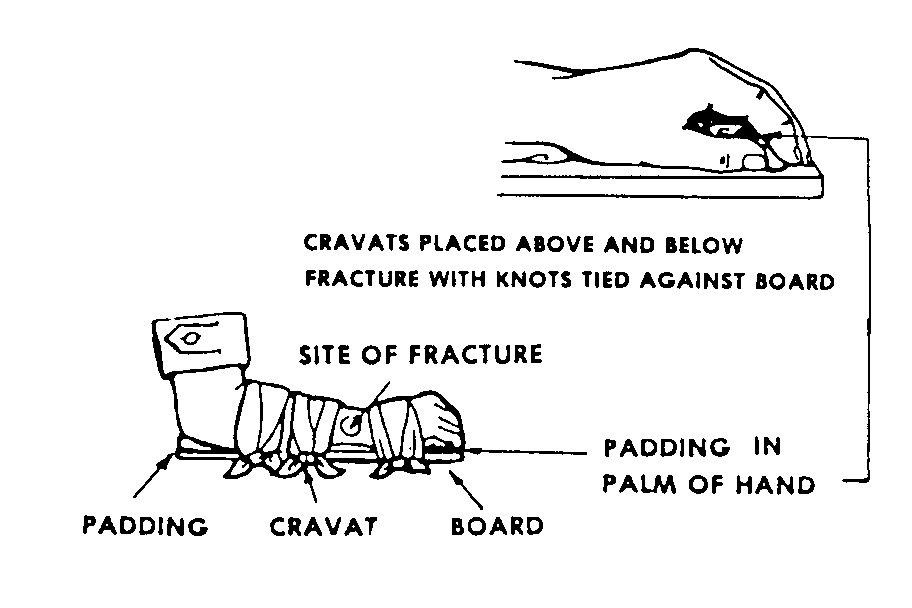
FIGURE 9-2. SINGLE-BOARD SPLINT APPLIED TO A FRACTURED WRIST
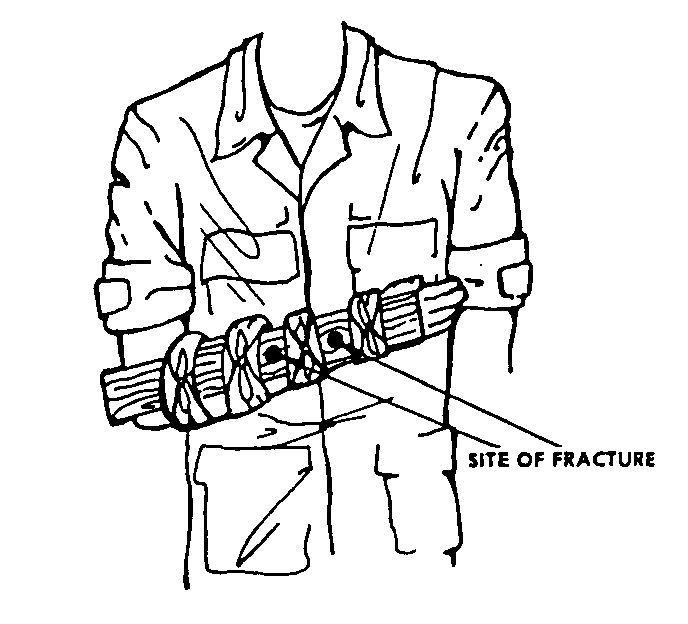
FIGURE 9-3. SPLINT APPLIED TO A FRACTURED FOREARM
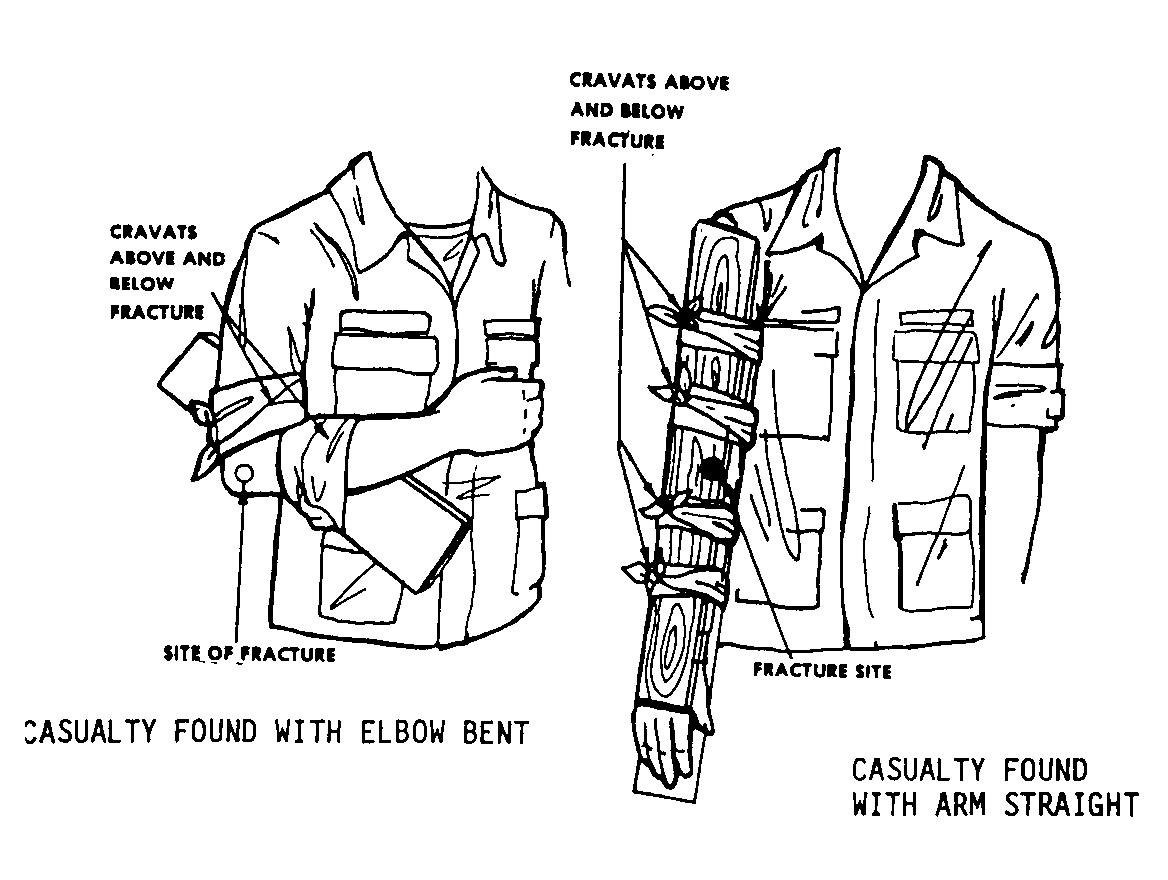
FIGURE
9-4. SPLINT APPLIED TO A FRACTURED ELBOW
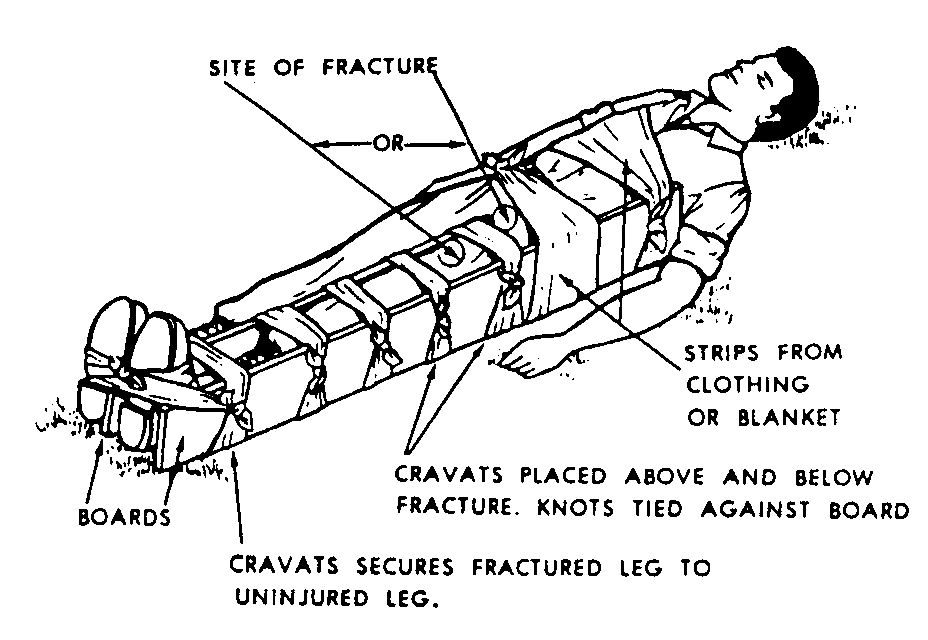
FIGURE 9-5. SPLINT APPLIED TO A FRACTURE OF THE UPPER LEG (THIGH)
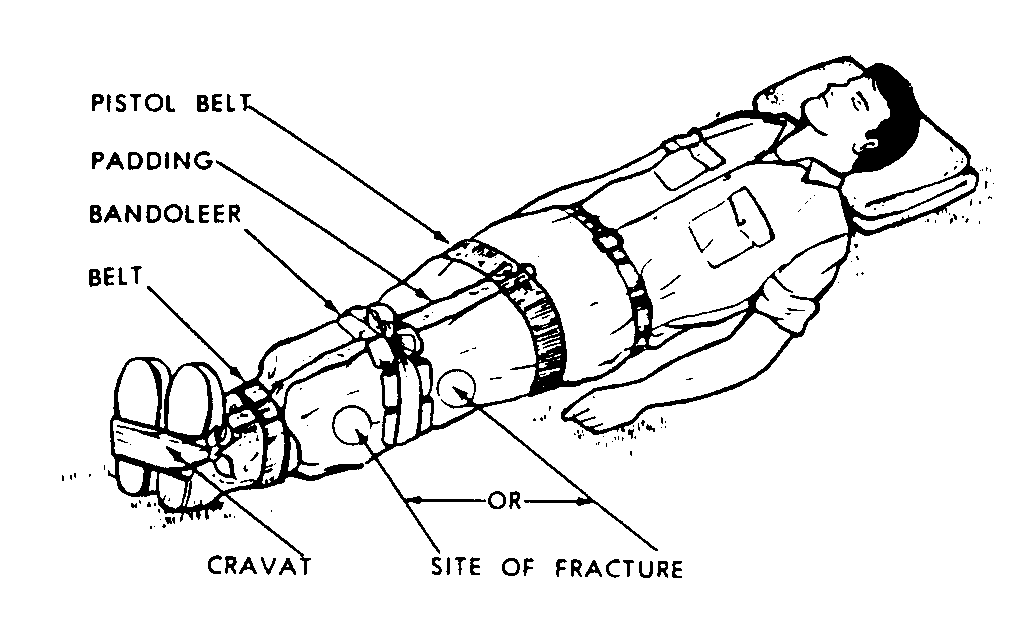
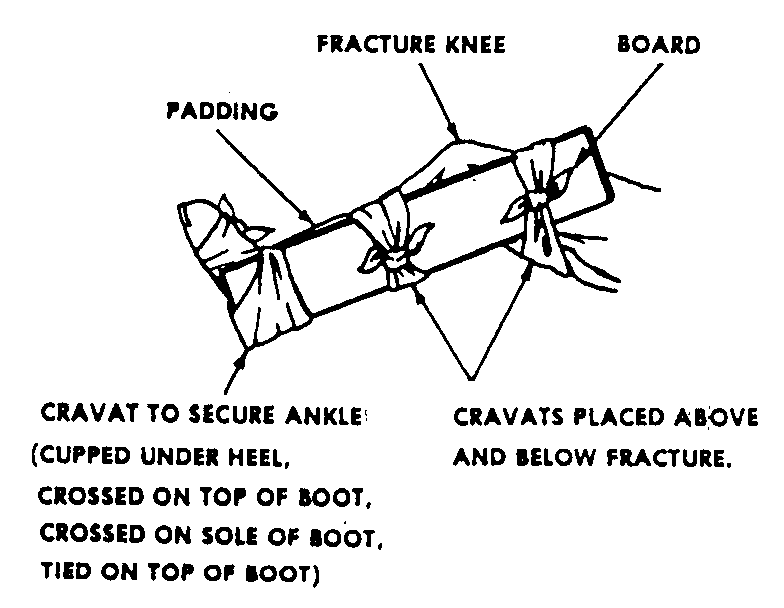
FIGURE
9-6. SPLINT APPLIED TO A FRACTURED KNEE (BENT)
FIGURE 9-7. UNINJURED LEG USED AS A SPLINT
9-6. APPLY A SLING AND SWATHE TO A FRACTURED ARM
A sling is usually used to secure and support a fractured forearm, wrist, or hand after the fracture has been splinted. When the upper arm is fractured, a sling and swathes can be used to immobilize the arm.
A sling can be made using a triangular bandage, strips of torn material, or the casualty's shirt or jacket.
a. Apply a Triangular Bandage Sling
A triangular bandage sling is usually made from a muslin bandage, but any material that does not stretch (such as a fatigue shirt, trousers, poncho, blanket, or shelter-half) can be used.
Fold, cut, or tear the material into a triangular shape (same as beginning a cravat).
Insert the material under the injured arm so that the arm is in the center, the apex of the sling is beyond the elbow, and the top corner of the material is over the shoulder of the injured side.
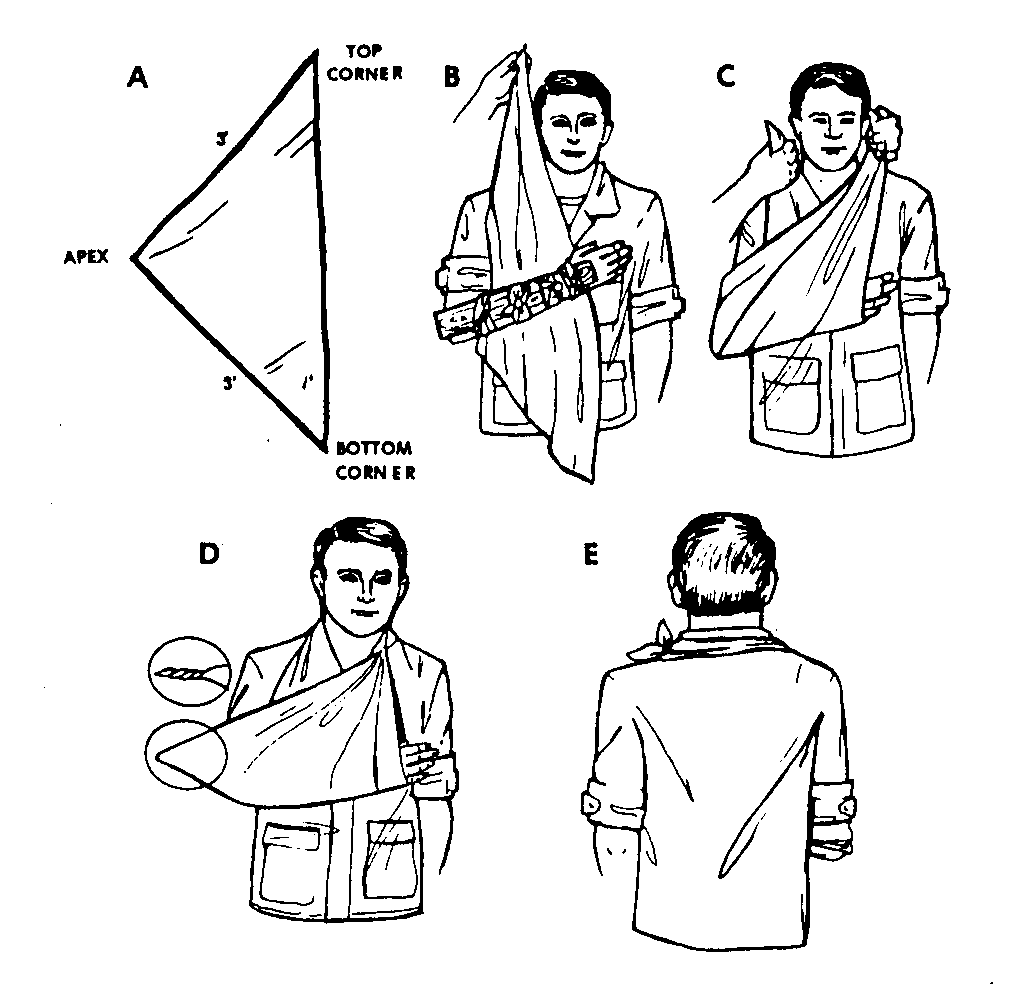
FIGURE
9-8. APPLYING A TRIANGULAR BANDAGE SLING
Position the forearm so that the hand is slightly higher than the elbow (about a 10-degree angle).
Bring the lower portion of the material over the injured arm so that the bottom corner goes over the shoulder of the uninjured side.
Bring the top corner behind the casualty's neck.
Tie the two corners together so that the knot will not slip. The knot should fit into the "hollow" at the side of the neck on the uninjured side. (If the casualty's right arm is fractured, for example, tie the knot so it will rest in the hollow on the left side of his neck.)
Twist the apex of the sling and tuck it in at the elbow. (The corner can also be secured using a safety pin.) This secures the elbow and keeps the forearm from slipping out of the sling.
b. Apply a Jacket Flap Sling
If the time or the materials to make a triangular bandage sling are not available, the flap of a BDU jacket (coat) or a field jacket (coat) can be used as a sling.
Position the forearm on the casualty's chest with the hand positioned slightly higher than the elbow.
Undo the jacket so that the lower portion (flap) can be brought over the arm to form a sling.
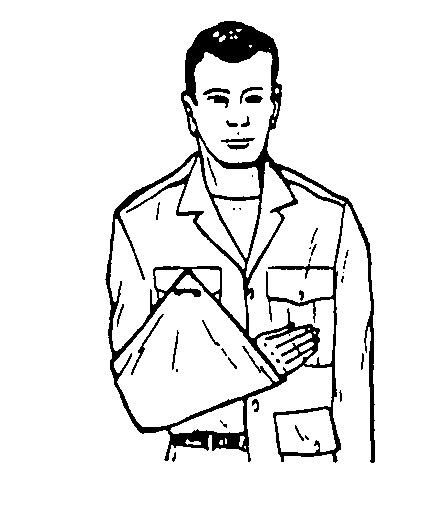
FIGURE
9-9. BDU JACKET FLAP SLING
Bring the flap up over the forearm to the pocket area. Position the elbow so the elbow is inside the sling and will not slip out of the sling.
Push a stick or other rigid object through the flap and the uppe,brr portion of the jacket so the flap will not slip.
c. Apply Swathes
A swathe is a large strip of cloth, muslin bandage, field dressing, blanket strip, pistol belt, trouser belt, bandoleer, or other material used to immobilize an arm. The swathe should be three to six inches wide. Two swathes are normally applied when the chest is used as a rigid object (one above the fracture and one below the fracture) or when the elbow is not bent.
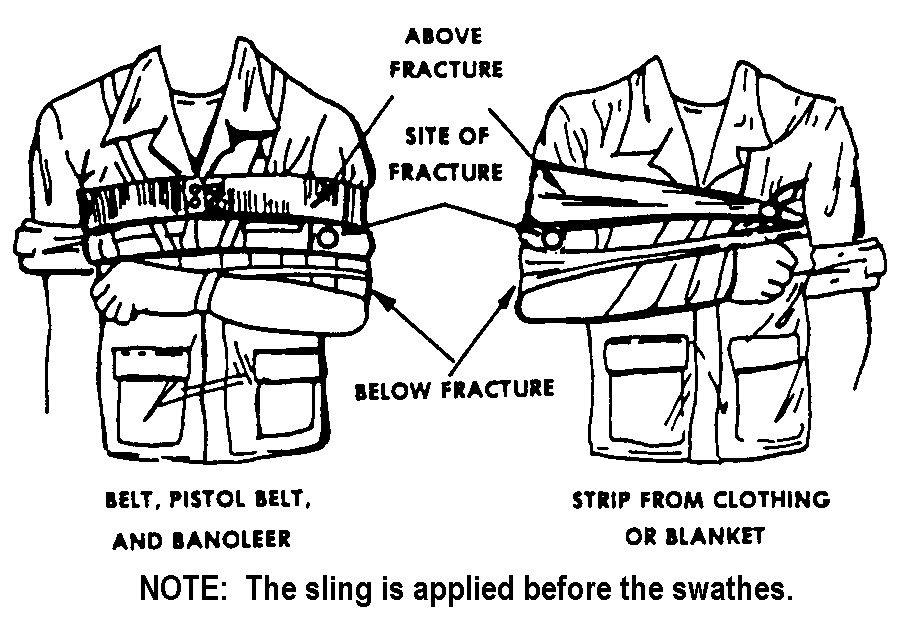
FIGURE 9-10. SLING AND SWATHES APPLIED WHEN CHEST
USED AS RIGID OBJECT
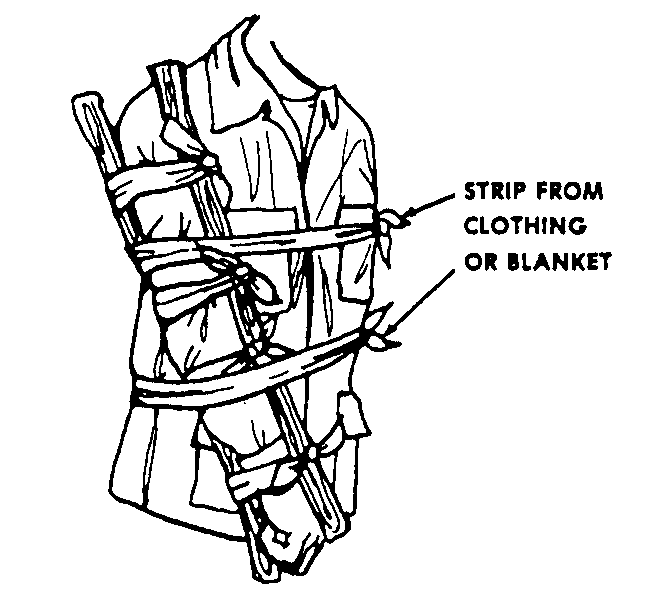
FIGURE 9-11. SWATHES APPLIED TO A FRACTURED ELBOWb>
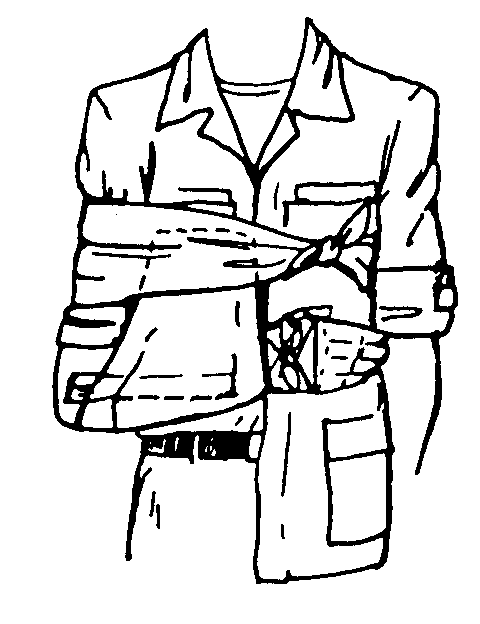
FIGURE
9-12. SLING AND SWATHE APPLIEDTO A FRACTURED FOREARM
CAUTION: Do not apply a swathe on top of the fracture site. The pressure of the swathe could cause additional damage to the nerves and blood vessels around the broken bone.
Normally, a single swathe is used to help immobilize the arm after a fractured forearm has been splinted and a sling applied. Steps for applying the swathe are given below.
Place one end of the swathe at the breast pocket near the uninjured arm.
Wrap the swathe across the sling, around the upper arm on the injured side, behind the casualty's back, under the uninjured arm, and back to the breast pocket.
Tie the two ends in a nonslip knot over the breast pocket on the uninjured side.